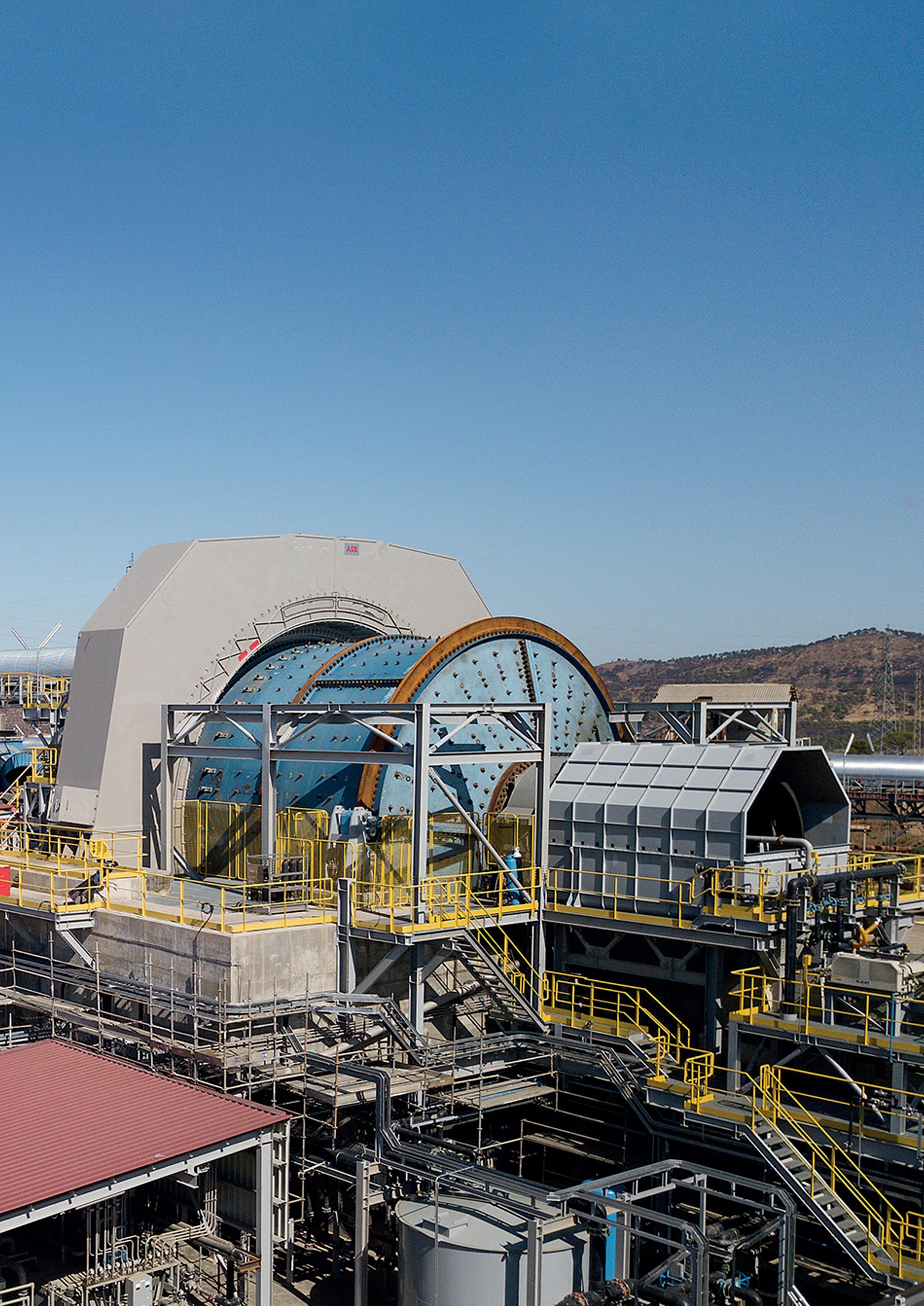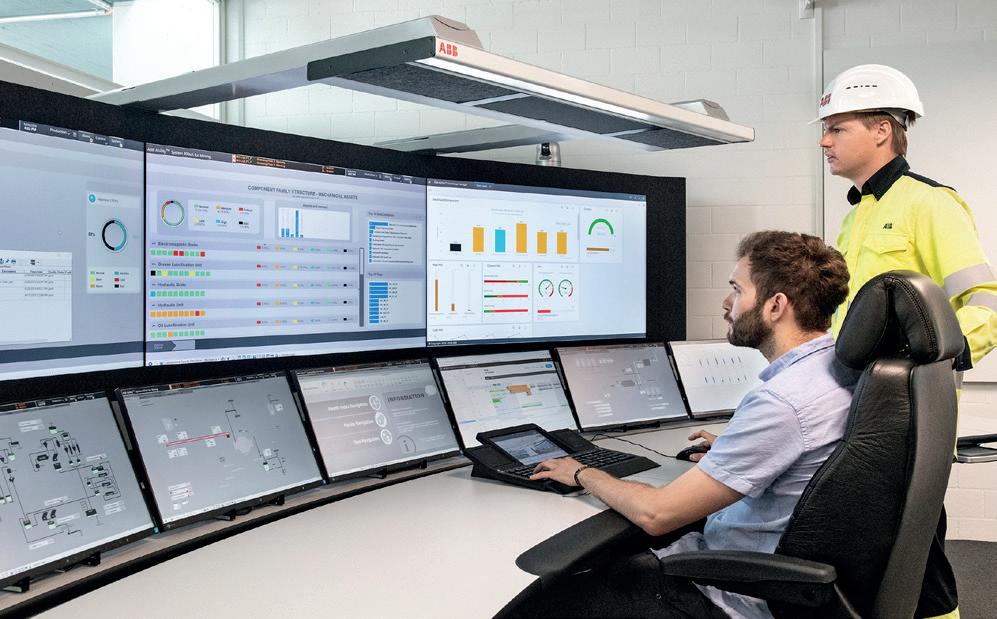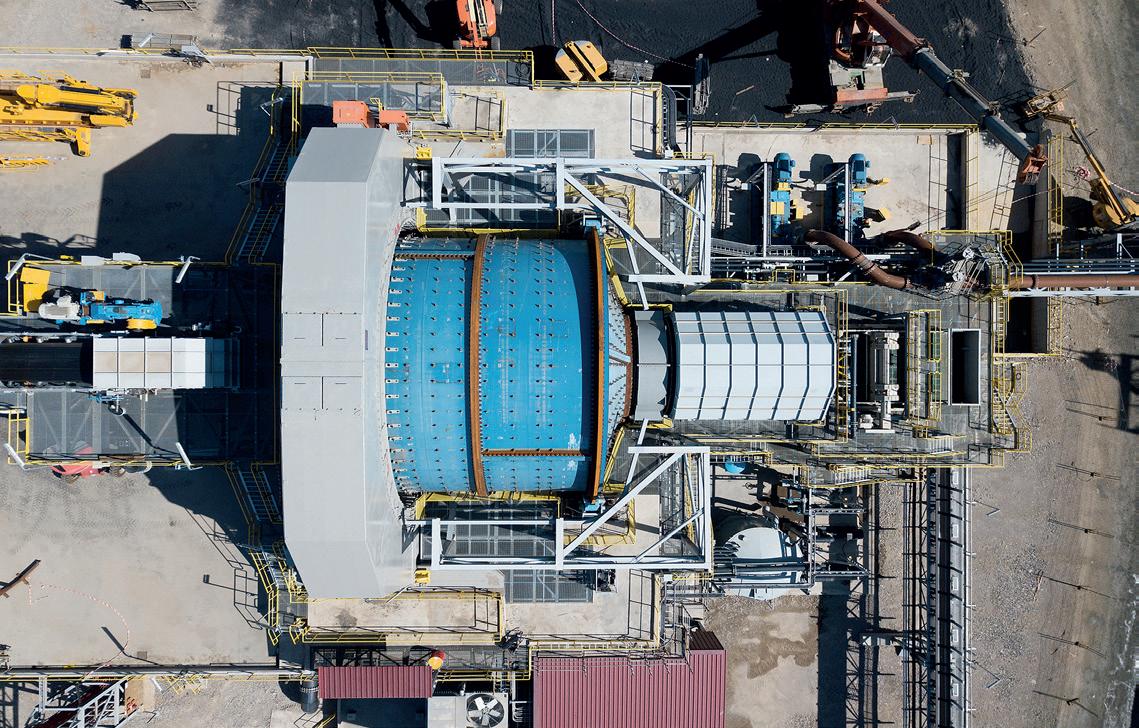
9 minute read
GMDs And The Clean Energy Transition
Marcelo Perrucci, ABB, explains why gearless mill drives (GMDs) are the preferred solution for high-capacity mills when combined with digital and service solutions.
Figure 1. ABB’s GMD supports Atalaya Mining’s operations in Andalucía.
Not only does mining provide the metals and minerals that 21st Century society relies upon – from cheap electronics, such as smartphones, to critical infrastructure, including houses and hospitals – it also provides the vital commodities such as lithium, copper and cobalt, that are required for electric vehicle batteries, wind turbines and solar panels, without which the clean energy transition cannot happen.
For this reason, demand is forecast to outstrip supply, and mine operators must commission new projects to bridge the gap. According to research by EY,1 published in April 2022, lithium production, for example, must quadruple from 490 000 t in 2021 to 2 million t in 2030, while the copper market is expected to be in deficit by nearly 4.7 million t by 2030 based on current supply projections.
The energy transition is also going to be expensive. EY forecasts that the mining industry will need to invest US$1.7 trillion over the next 15 years to supply enough critical metals, such as; copper, cobalt, and nickel.
For mining companies, this inexorable rise in demand for commodities is matched by a significant decline in ore grades. This means they must build larger mills to optimise production and increase throughput, while simultaneously reducing energy usage and maintaining quality control.
Less is more: The benefits of GMDs
Gearless mill drives (GMDs) can help achieve these goals by offering superior efficiency, availability, and uptime in large semi-autogenous (SAG), ball, and autogenous mills characterised by higher ball charges and demanding ambient conditions, compared with traditional ring-geared alternatives.
Fitted with multiple sensors, GMDs also gather and transmit large amounts of granular data, which can then be analysed and used to facilitate predictive rather than reactive maintenance. This keeps costly downtime to a minimum, and gives mill operators better visualisation and control over production.
In a conventional mill drive system, the ring-gear, pinion, gearbox, coupling, motor shaft, and motor bearings transmit the torque from the motor to the mill. In a GMD, however, the torque is instead transmitted through the magnetic field in the air gap that exists between the stator and rotor.

By mounting the rotor poles directly onto the mill, the mill becomes the rotor of the gearless motor.
This design delivers significant efficiencies when deployed at scale. Large SAG, ball, and autogenous mills, for example, may have several 15 – 25 MW GMDs running at the same time. By eliminating large, maintenance-heavy mechanical components, GMDs can improve efficiency by as much as 3%, limiting energy consumption and contributing to decarbonisation efforts by reducing CO2 emissions. Mining companies can choose to consider GMDs even for lower-than-usual powers (<18 MW), because they offer high efficiency and availability and can be a significant contributor towards more sustainable mines.
ABB GMDs, coupled with the digital monitoring system, ABB AbilityTM Predictive Maintenance for grinding, are increasingly becoming the preferred solution for mills that require 16 MW or more, which are typically characterised by higher-capacity production coupled with low ore grades.
ABB Ability Predictive Maintenance for grinding is an advanced digital condition monitoring solution that analyses GMD systems, increases safety through continuous checks, and considers both past and real-time data; in order to anticipate maintenance requirements and avoid unplanned production downtime.
The system monitors critical asset conditions, which are then automatically compared to pre-defined thresholds. If the system reaches critical status, an alarm is dispatched to both the customer and an ABB expert. The expert connects to the system, checks the condition and then contacts on-site personnel with recommended actions to normalise operations, and to prevent possible downtime of the GMD.
Predictive maintenance and service
ABB Ability Predictive Maintenance for grinding, combined with ongoing life cycle management support, is being used by Atalaya Mining to optimise the availability and performance of the SAG mill at its flagship Rio Tinto project, which produces copper concentrates and silver by-product, in Andalucía, Southwest Spain.
ABB’s GMD is the ‘workhorse’ for the grinding operations, providing reliability and availability at the processing plant. Following a recent 15 million tpy expansion, Rio Tinto increased its annual copper production target to approximately 55 000 tpy.
Atalaya and ABB’s long-term service agreement (LTSA) with an ABB Lifecycle Manager has supported a production record at Rio Tinto in 2020, and mine production was approximately the same in 2021.
The LTSA covers lifecycle management to plan, coordinate, and execute services – including corrective, preventive and predictive system maintenance, with rapid response to emergency calls – as well as an adaptive approach to modifications in production, maintenance, or shutdown schedules. Overall, the LTSA maximises availability, optimises asset performance, and facilitates safe operation through a single-point-of-contact (ABB’s Remote Diagnostic Services), routine maintenance, and upgrades.
The new cloud-based predictive maintenance for grinding includes a new mobile application that allows real-time notifications on fleet status.2 The platform aims to extend the life of grinding assets by providing easy access to GMD system parameters, allowing visualisation of performance through considering past activity and real-time data, and assessing future maintenance requirements.
Used in conjunction with the ABB Grinding Connect app, available for iOS and Android, operators can monitor the performance of a GMD at any time and from any place through a phone or tablet.
The ABB GMD – one of more than 150 awarded by customers around the world over the past 50 years – draws on the company’s overarching distributed control system, ABB Ability System 800xA, and offers a range of additional advanced mill control functions; including frozen charge detection, frozen charge remover, controlled rollback, automatic positioning, as well as advanced monitoring.

Figure 2. ABB Ability™ Predictive Maintenance helps extend asset lifetime and avoid unforeseen downtime.
Monitor what is happening inside your mill
As the demand for GMDs increases, and technology advances, so does ABB’s portfolio of solutions.
ABB Ability Cascade Monitoring uses a wireless sensor device attached to the shell of the mill to measure key grinding features online, and share this data with the plant’s control system. Based on this, operators can assess the milling efficiency and whether current conditions are causing excessive wear on liners, adjusting parameters accordingly to improve both grinding stability and profitability.
The ‘plug and play’ sensor nodes are attached to the mill shell via magnets and begin instantly to communicate with the base station, measuring the complete 360˚ spectrum of vibration inside the mill – including the amplitude of vibrations that can help indicate abnormal ball hits to liners.
By integrating the new cascade monitoring solution with Advanced Process Control (APC), such as ABB’s Ability Expert Optimizer platform, milling features can be included in closed loop optimisation strategies to improve milling efficiency by determining and stabilising shoulder and toe angles.
In summary, cascade monitoring can be used to reduce energy consumption and costs; reduce liner wear by exposing key milling features that can directly be linked to high liner wear rates; and improve operator visibility of current milling conditions by providing further information via the plant’s process control system.
Manufacturing excellence as standard
Manufacturing excellence is at the heart of ABB’s gearless mill drive ring motor factory located in Bilbao, Spain.3 Here, a wealth of experience, the integration of all manufacturing processes, and a network of local suppliers help create complex, customised technological drive solutions that are suited to all altitudes and operating conditions. Investment in facilities, people, and infrastructure at the Bilbao factory means ABB is confident in its delivery against a very healthy pipeline of orders both this year and for other longer term projects, to high levels of manufacturing excellence. Investment at the Bilbao factory has been set at US$1.3 million for 2022, with total CAPEX investment reaching US$10 million since the 2013 acquisition of the site. Approximately 60 jobs have been created at the site in the past 12 months alone.
During the manufacturing phase, the 120 000 or so segments that will form each motor’s magnetic core are cut and tested to avoid the appearance of hotspots. The segments undergo a vacuum pressure impregnation process (VPI) to make them more resistant to the harsh environments of mining.
Approximately 1000 of the bars that form the fundamental components of the ABB gearless motor drive undergo winding for each drive, and the assembly process is completed on site in the mine. Throughout the entire process, the integrity and quality of the components and their assembly is accomplished by strict control of internal processes, in conjunction with ABB’s main suppliers.
Why mill size matters

Figure 3. The new Grinding Connect mobile application will allow operators to check on their asset from anywhere.
Figure 4. The SAG mill at Atalaya Mining's Rio Tinto site from above. In summary, GMDs offer significant advantages in terms of availability, reliability, flexibility, and efficiency compared to conventional drives. By eliminating bolt-on mechanical components, such as ring-gears, pinions, couplings and gearboxes, frictional losses and equipment wear and tear is kept to a minimum, while fewer critical components equates to reduced maintenance and OPEX.
In addition, operators can gather and analyse real-time data from sensors in the drives – everything from insulation deterioration to vibration in the core to the temperature of poles and windings – and use this data to identify and address issues before they occur, boosting production efficiency.
Partnering with a trusted technology provider at the earliest stage of a GMD design and installation project ensures a custom-built drive solution that offers the highest possible grinding performance with quick return on investment. ABB’s mining engineering team has more than 60 years of experience in grinding and in that time has delivered in excess of 300 mill drives worldwide, including some of the world's largest GMDs: a 22 MW GMD for a 28 in. ball mill, 28 MW GMD for a 40 in. and 42 in. SAG mills.4 Larger ball and SAG mills boasting higher installed power ratings relative to the mill diameter offer higher efficiency and throughput, 24/7 reliability and the ability to mine in remote areas, making low ore grades economical to grind – all factors that are important as demand for commodities grow. Powered by the latest GMDs, and backed by sensor and monitoring technologies that give operators real-time visualisation and control over production, these mills will be on the frontline of the battle to sustainably produce the metals and minerals the world needs to transition to renewable energy.
References:
1. BONTJE, H. and DUVAL, D., ‘Critical minerals supply and demand challenges mining companies face’, EY Americas, (25 April 2022), https://www.ey.com/en_us/mining-metals/ critical-minerals-supply-and-demand-issues. 2. ‘ABB steps up with new version of digital service for grinding – incuding mobile app,’ ABB, (25 January 2022), https://new.abb.com/news/detail/86754/abb-steps-upwith-new-version-of-digital-service-for-grinding-includingmobile-app. 3. ‘ABB Gearless Mill Drive in Ring Motor Factory in Bilbao’,
ABB in Mining, (23 June 2022), https://youtu.be/ iAsAsGM3amc 4. ‘Gearless mill drives’, ABB, (5 September 2022), https:// library.e.abb.com/public/46de79b27d634a56820de89839eb 7eea/Gearless_mill_drives_LR_web.pdf








